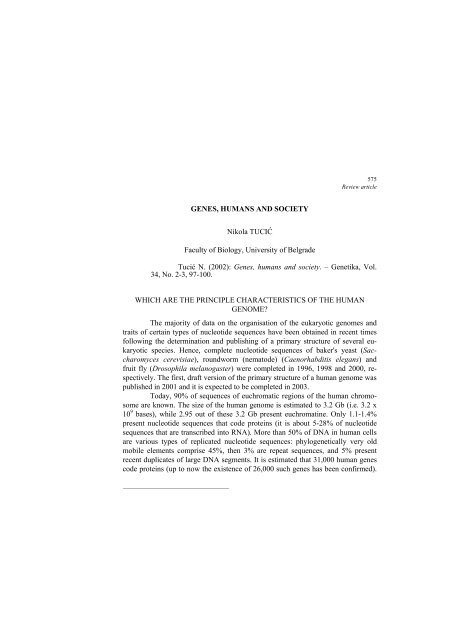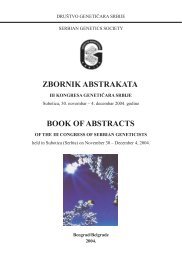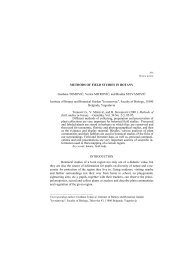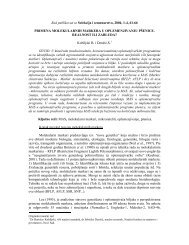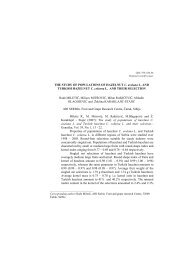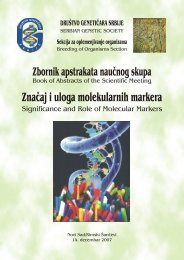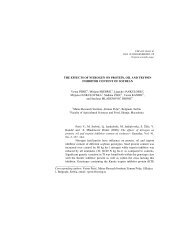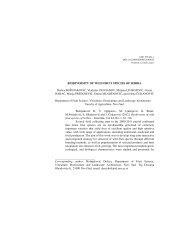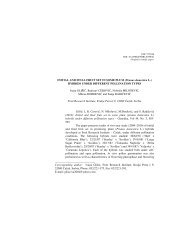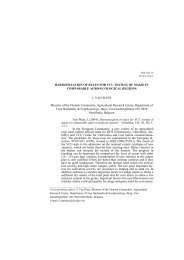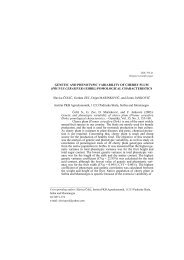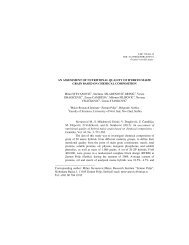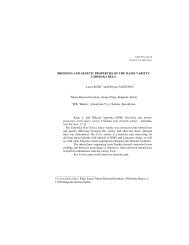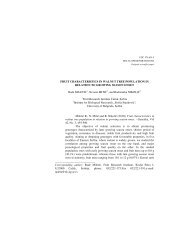Genes, humans and society
Genes, humans and society
Genes, humans and society
Create successful ePaper yourself
Turn your PDF publications into a flip-book with our unique Google optimized e-Paper software.
GENES, HUMANS AND SOCIETY<br />
Nikola TUCIĆ<br />
Faculty of Biology, University of Belgrade<br />
575<br />
Review article<br />
Tucić N. (2002): <strong>Genes</strong>, <strong>humans</strong> <strong>and</strong> <strong>society</strong>. – Genetika, Vol.<br />
34, No. 2-3, 97-100.<br />
WHICH ARE THE PRINCIPLE CHARACTERISTICS OF THE HUMAN<br />
GENOME?<br />
The majority of data on the organisation of the eukaryotic genomes <strong>and</strong><br />
traits of certain types of nucleotide sequences have been obtained in recent times<br />
following the determination <strong>and</strong> publishing of a primary structure of several eukaryotic<br />
species. Hence, complete nucleotide sequences of baker's yeast (Saccharomyces<br />
cerevisiae), roundworm (nematode) (Caenorhabditis elegans) <strong>and</strong><br />
fruit fly (Drosophila melanogaster) were completed in 1996, 1998 <strong>and</strong> 2000, respectively.<br />
The first, draft version of the primary structure of a human genome was<br />
published in 2001 <strong>and</strong> it is expected to be completed in 2003.<br />
Today, 90% of sequences of euchromatic regions of the human chromosome<br />
are known. The size of the human genome is estimated to 3.2 Gb (i.e. 3.2 x<br />
10 9 bases), while 2.95 out of these 3.2 Gb present euchromatine. Only 1.1-1.4%<br />
present nucleotide sequences that code proteins (it is about 5-28% of nucleotide<br />
sequences that are transcribed into RNA). More than 50% of DNA in human cells<br />
are various types of replicated nucleotide sequences: phylogenetically very old<br />
mobile elements comprise 45%, then 3% are repeat sequences, <strong>and</strong> 5% present<br />
recent duplicates of large DNA segments. It is estimated that 31,000 human genes<br />
code proteins (up to now the existence of 26,000 such genes has been confirmed).<br />
_______________________________
98 GENETIKA, Vol. 34, No. 2-3, 97-100, 2002.<br />
On the other h<strong>and</strong>, approximately 6,000, 13,000, 18,000 <strong>and</strong> 26,000 genes, coding<br />
proteins, were detected in baker's yeast, platyhelminths, fruit fly <strong>and</strong> mouse-ear<br />
cress, respectively. Only 94 of 1278 (or 7.4%) of protein families are coded by<br />
human genes that are specific for vertebrates. It is estimated that 47 genes coding<br />
proteins were formed of mobile genetic elements, while 223 probably originated<br />
from bacteria, i.e. they are present in the human genome as a result of the horizontal<br />
evolution. Alternative intron excision is present in about 35% of genes. <strong>Genes</strong><br />
coding proteins in <strong>humans</strong> have small exons (about 50 codons) <strong>and</strong> very long introns<br />
(length of some of them is up to 10 kb).<br />
WHAT IS AN INNATE/ACQUIRED CONTROVERSY?<br />
Many discussions have been taken in psychology in relation to the roles of<br />
biological ("innate") <strong>and</strong> cultural ("acquired") factors in the formation of human<br />
behaviour. There are four approaches to this problem. 1. Biological determinism<br />
is the belief that individual biological differences, such as those related to neuroanatomy,<br />
hormones <strong>and</strong> finally genes, are responsible for all types of human behaviour.<br />
2. Social constructivism (syn. empiricism) on the other h<strong>and</strong>, emphasises<br />
the influences of cultural <strong>and</strong> social contexts in human behaviour. 3. Interactionism<br />
is believed to be a process of interaction of both biological <strong>and</strong> social factors<br />
that determine human behaviour. 4. The theory of developmental systems claims<br />
that any separation of innate from acquired is artificial, because all types of human<br />
behaviour are a result of a complex system within reactions whose parts cannot be<br />
treated as discrete units.<br />
WHAT ARE INNATE TRAITS?<br />
1. In the context of genotype-phenotype relation - for the majority of<br />
ethologists, psychologists <strong>and</strong> many geneticists the innateness of a certain trait is<br />
another term for the trait caused by genes. In other words, the trait is either "innate"<br />
or "acquired" if the development of the given organism is "closed" for environmental<br />
effects on the given trait. The innate or genetic traits are, according to this<br />
concept, "ontogenetically fixed", i.e. all pecies of information necessary for the<br />
development of the individual would be coded in its genotype. Many researchers,<br />
such as evolutionary physiologists <strong>and</strong> sociobiologists, who accept the concept of<br />
ontogenetic fixation are of the opinion that innate traits are always adaptations.<br />
Any modification of the "normal" environment (i.e. of the one for which adaptation<br />
is an innate trait) that would change the condition of the given trait would not represent<br />
a natural variability of a phenotype, i.e. phenotypic adaptability, but "abnormality"<br />
("aberration" or "pathological condition"). Furthermore, according to a<br />
famous ethologist Konrad Lorenz <strong>and</strong> his followers who support the concept of<br />
ontogenetic fixation of innateness, if a trait "requires" an environmental stimulus<br />
for its "natural development" under normal conditions it means that that trait is not<br />
an innate one. Therefore, the innate trait is a trait which is entirely determined by<br />
genes under normal conditions. For instance, children who had misfortune to grow
N:TUCIĆ: GENES, HUMANS AND SOCIETY 99<br />
up without a possibility to communicate with other people did not develop linguistic<br />
abilities (which indicates to the development of neurological components of the<br />
language <strong>and</strong> speech <strong>and</strong> to the fact that their functional conditions depend on<br />
stimuli coming form other people in early periods of the postnatal development);<br />
according to the concept of ontogenetic fixation, the language is not the innate trait<br />
in <strong>humans</strong>, although it is very clear that only they have genetically determined neural<br />
structures that establish the mode by which linguistic elements (such as words)<br />
are used to form rational sentences (syntax) regardless of the language itself. The<br />
concept of innateness based on ontogenetic fixation is in collision with the contemporary<br />
genetics, which has inevitably shown that all traits of an organism presented<br />
a result of interactions between genes <strong>and</strong> environments under which the<br />
development of the organism was conducted. In other words, both, genes <strong>and</strong> environments<br />
are causal factors for each trait of an organism.<br />
2. In the context of differences among population individuals - the original<br />
<strong>and</strong> fundamental meaning of the term "innate" or "genetic" trait in the contemporary<br />
biology is: a trait is "innate" one if phenotypic differences among individuals<br />
in a given population can be explained by genetic differences.<br />
WHICH ARE THE BASES OF THE CONTEMPORARY GENETIC<br />
DETERMINISM?<br />
The belief of the contemporary genetic determinism is that evolutionary<br />
biological considerations have a crucial role in underst<strong>and</strong>ing of our own selves,<br />
our behaviour <strong>and</strong> validation systems. It is claimed that social policy, legislation<br />
<strong>and</strong> ethical systems of human societies have to be within frames provided by the<br />
genetics. Culture is an epiphenomenon; it is said that the crown of the genetics can<br />
be used to "hide a reality from us". The human being is described as a selfish, aggressive<br />
creature that functions the best within a group which permits him without<br />
any limitation set by modern societies, to express absolutely freely his own biological<br />
instincts. The ambition of sociobiology <strong>and</strong> evolutionary psychology is<br />
greater than the "explanation" of human nature; it is an attempt to develop a total<br />
explanatory system of the human social existence.<br />
WHAT IS THE EVOLUTIONARY PSYCHOLOGY?<br />
The majority of people encountering the term "evolutionary psychology"<br />
thinks of it as a discipline relating to studies on the evolution of cognitive abilities<br />
<strong>and</strong> behaviour. However, over the last ten years, the evolutionary psychology have<br />
been developing into a specific research programme based on very explicit nativistic<br />
<strong>and</strong> adaptive interpretations of evolutionary mechanisms exclusively related to<br />
human mental abilities <strong>and</strong> behaviour. There are several essential principles characteristic<br />
for this research programme. The majority of evolutionary psychologists<br />
<strong>and</strong> anthropologists believes that aspects of human behaviour, traditionally studied<br />
by the psychology <strong>and</strong> anthropology, can <strong>and</strong> have to be explained by numerous<br />
inner computer-like mechanisms whereby each of them presents an adaptation that
100 GENETIKA, Vol. 34, No. 2-3, 97-100, 2002.<br />
occurred due to effects of natural selection in environments that were inhabited by<br />
the first members of the genus Homo. Since the appropriate psychological adaptations<br />
permitted primitive <strong>humans</strong> to solve specific problems they were encountering<br />
in environments of that time, it is quite obvious to expect that "cognitive architecture"<br />
of modern <strong>humans</strong> comprises of numerous (perhaps of several thous<strong>and</strong>s)<br />
special purposeful mechanisms ("specialised modules"). Considering that<br />
the appropriate selection regimes were present long ago in an environment often<br />
named the "environment of evolutionary adaptiveness" (EEA) <strong>and</strong> were dated as<br />
far as the Pleistocene (pertaining to the geologic epoch forming the earlier half of<br />
the Quaternary Period, beginning about two million years ago <strong>and</strong> ending ten thous<strong>and</strong><br />
years ago) the majority of psychological mechanisms of today are not adaptive,<br />
if great changes in the environment of <strong>humans</strong> are considered. However, such<br />
traits would today be inherited or innate dispositions of <strong>humans</strong>. Numerous examples<br />
of such traits could be found in the recently published book Genome by Met<br />
Ridley (2001) that popularise principal ideas of the evolutionary psychology.<br />
Received 1. X 2002.<br />
Accepted 16. XII 2002.


